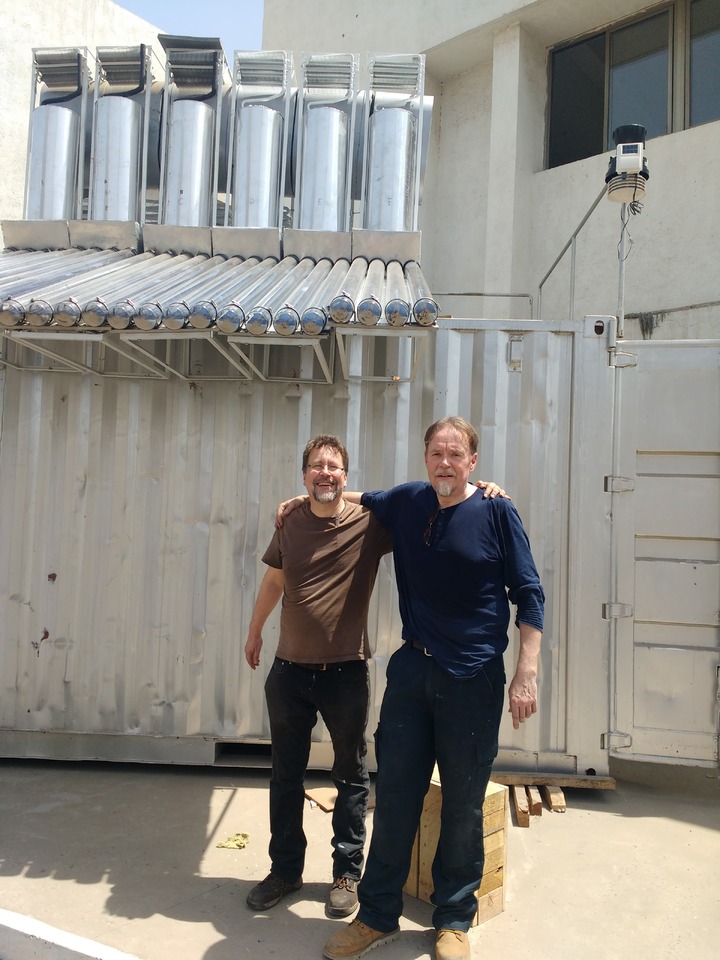Sun brings cool solution to vaccine preservation problem
10 January 2019‘World class’ and a ‘breath of fresh air’ is how researchers at the University of Sheffield AMRC were described by a renewable energy start-up whose solar refrigeration technology could be used to preserve life-saving vaccines and vital food in some of the hottest and most remote places on earth.
Solar-Polar, a Peterborough-based company on a mission to take solar cooling to the developing world, approached the AMRC’s Design and Prototyping Group (DPG) to request design assistance to help cut volume manufacturing costs for its innovative cooling system.
John Spencer, Senior Project Manager at the DPG said: “Solar-Polar's technology offers the flexibility and potential to be scaled up to target specific applications, such as bulk storage of vaccines. This off-grid renewable cooling system, functioning from solar energy alone and removing the reliance upon mains electricity, provides a secure, low-cost and low carbon solution to the fundamental problem of vaccine refrigeration and food storage.”
Countries of high climatic temperature, particularly in remote regions with limited or no mains electricity, require an alternative means of refrigeration and air conditioning. Solar power may seem an obvious choice but solar-powered refrigeration systems rely on photovoltaic panels, control systems, batteries and moving mechanical parts prone to wear and failure, requiring regular maintenance.
Solar-Polar has invented a technology that provides a robust electricity-free, purely thermal alternative but needed help to simplify its design to make it cheaper to mass manufacture.
The project, carried out through a Catapult-funded SME scheme run by the Advanced Manufacturing Research Centre (AMRC), involved reviewing selected components in the cooler assembly to reduce manufacturing costs. Conceptual ideas around changes to the existing design were also proposed.
Michael Reid, Engineering Director at Solar-Polar, said: “The AMRC is a breath of fresh air when it comes to assistance for small start-ups. The engineers we dealt with were extremely quick to understand what we needed and their work was world-class.
“We were recommended to the AMRC by a business contact because we needed to get an up-to-date idea of how our product might be made in volume and at a low mass-production cost.
“As a start-up on our way to a high volume product we were keen to deal with an organisation who not only knew manufacturing intimately but were able to rapidly grasp what we needed and deliver answers quickly and effectively.
“We weren't disappointed. The report we got not only gave us the answers but was also a document that we have been able to share with partners and investors.”
A number of key system components were identified for consideration by the DPG team. The work resulted in a number of recommendations being made to reduce complexity, and in turn manufacturing costs, including concept design recommendations for future development.
AMRC research engineer Matthew Wilkinson said: “The project was about assessing Solar-Polar’s initial system design from a volume manufacturing perspective, and identifying the components that would be challenging and costly to mass produce, providing suggestions for design changes based upon target production volumes.
“The reduction of complexity in a system can significantly lower manufacturing costs, such as combining parts or removing unnecessary components. The standardisation of parts can also reduce complexity because common components can be used multiple times throughout the system, reducing tooling and manufacturing cost.”
The DPG has worked with Solar-Polar and other research organisations to submit a project proposal to Innovate UK to carry out the detailed design and development work packages necessary to advance the technology to a pre-production stage. Feedback on this is expected later this month.
John Spencer added: “The SME assist undertaken for the company was a small package of work, focused on a select number of components. A much larger project is required to advance the suggested design changes and develop the rest of the system.
“If the final system can be manufactured at the required volumes and cost, it has the potential to radically improve the lives of rural households, communities and farmers in Africa and South Asia, as well as others in remote regions.
“By developing the system to a stage where it can be cost-effectively manufactured in volume, its potential can be realised for the benefit of communities unable to access affordable means of cooling, particularly in the growing rural populations of sub-Saharan Africa, where access to electricity is only available to a small minority.
“At a local level, the project will further promote the capabilities of the AMRC to SMEs. It will provide a clear product development route for companies working to tackle the physical challenges affecting developing countries.”




